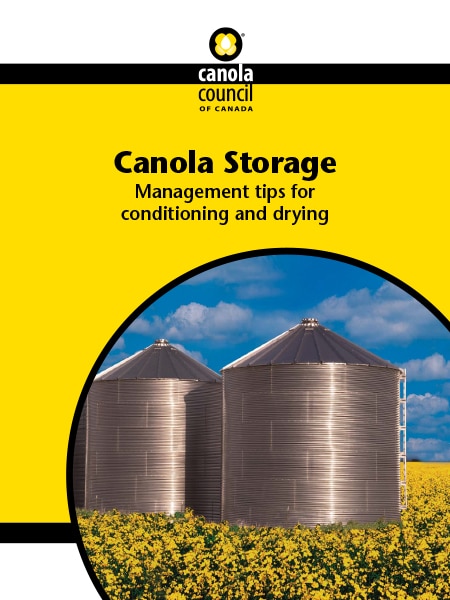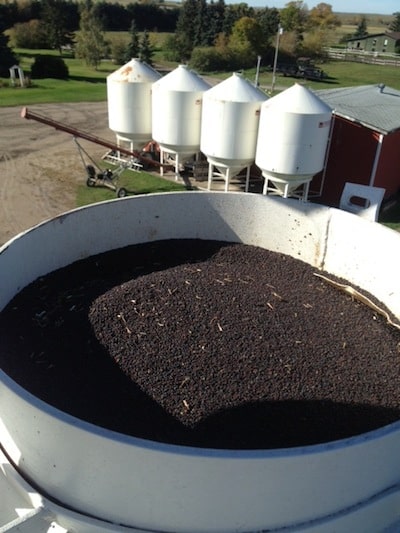All canola should be conditioned immediately after combining to cool it down, provide for consistent temperature throughout the bin and remove any moisture released through natural seed respiration that occurs in the first hours to weeks after harvest.
After that, monitor bins closely during the first six weeks after harvest and then continue to check stored canola regularly until delivery. This is especially true for canola at higher risk of spoilage.
The ideal situation for safe long-term storage is canola seed moisture of eight per cent of less and temperatures of 15°C or less. If stored canola temperatures plateau or start to rise while outside air cools through the winter, it can signal the start of spoilage. It only takes one small hot spot to start a chain reaction that can spoil a whole bin.
How to check bins
1. Cycle. The best method, even with bin monitoring cables, is to remove about a third of the canola. This disrupts the moisture cycle and helps to stop any heating or spoilage that may have begun in the central core. While unloading, feel and smell canola as it comes out of the bin. Check for visual abnormalities such as sweating. Run another moisture and temperature test. In the absence of adequate temperature sensors, this is probably the only effective way to determine if core temperatures are still high in large storage structures. If canola has any hint of spoilage, consider cycling the whole bin.
2. Use bin monitoring cables. These give a quick assessment of temperature (and some also offer moisture) readings at nodes throughout the bin. One cable has a coverage diameter of 20 to 24 feet. Bins with a diameter greater than 24 feet will need at least three cables to adequately monitor grain temperature. Cables may not detect small hot spots, so cycling can offer some extra assurance.
3. Probes. Probing through doors or roof hatches may uncover hot spots near the bottom and top of the bin, but cannot show canola condition through the central core and all sides. Be careful and consider your own safety when climbing bins to probe grain. Reduce your risk of falling by using appropriate safety equipment such as a harness.
How to check bags
If leaving bags for the winter, watch them regularly. Feel them for warm temperatures. Probe them if possible. Tape up any holes that may occur due to wildlife or any other damage. Spoilage in bags often starts around holes.
Bags are suitable for short-term storage of tough canola. A Saskatchewan study from 2009 compared bag storage of canola at 12, 13 and 14 per cent moisture. At 14 per cent moisture, canola in the study did not cool down as expected when outside temperatures cooled, so growers emptied those bags in December. A more recent and intensive University of Manitoba study (part one, part two) came to the same conclusion. Canola at moisture levels above 12 per cent should only be stored for three to four weeks to avoid deterioration of quality.
The risk with bags is that most don’t have airflow, they tend to fluctuate more with changes in outside temperature (which means they cool faster but also warm up faster), and they are often not as accessible in winter if something goes wrong.
More…
- TIP: Moisture testers are not designed to work on cold grain. To avoid moisture tester error, put the sample in a sealed container (to allow the sample to come to equilibrium), bring it inside and wait 6 to 12 hours before testing.
- Canola Encyclopedia – Storage chapter
- Canola Research Hub – storage research projects
- Companies that buy off-grade canola
- Canola Digest – New tech checks bins


